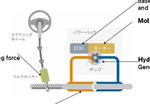
Nissan managed to double the Fuel Cell power density of their new generation unit. Nissan achieved double the power of its fuel cell thanks to MEA (Membrane Electrode Assembly) which features improved conductivity of the electrolyte layer. The cell structure of the new generation fuel cell features a new thin metal separator, which replaces the previous carbon one.
The new Nissan fuel cell uses a higher durability electrode material that results in 50% reduction of the platinum required, which in turn results in lower cost.
Nissan Press Release:
Nissan Motor Co., Ltd. has developed a new fuel
cell stack with double the power density of the previous generation stack. The new fuel cell stack also achieves a 35% cost reduction mainly due to half the use of platinum, a key material used in the production of fuel cell stacks. Test fleets incorporating the improved fuel cell stacks will be operational by the end of this year.
MEA (Membrane Electrode Assembly): Double the power density is achieved through improved conductivity of the electrolyte layer within the MEA, where the main chemical reaction occurs,
coupled with a more densely-packed cell structure.
Cell Structure: A more densely-packed cell structure is achieved through the replacement of the carbon separator with a new thin metal separator. The separator functions to break down the hydrogen, oxygen and cooling water necessary for the chemical reaction. A specific coating applied to the separator helps improve conductivity and prevents chemical corrosion, leading to increased efficiency and durability throughout the fuel cell stack’s life-cycle.
Electrode: Higher durability electrode material
results in a 50% reduction of the platinum required compared to the previous generation. This in turn, provides a significant breakthrough in the cost of these components.
Stack size and cost: The combined improvements in the cell result in double the power density, which enables a downsizing of the fuel cell stack size by one-third and significant cost reduction, without sacrificing performance. Compared to the previous generation, the new generation stack’s power output is increased 1.4 times from 90kW to 130kW, which can power larger vehicles.
Stack size is reduced by 75% to 68L from 90L, which allows for improved packaging flexibility.
The next generation fuel cell stack is amongst a range of eco-friendly technologies being pursued by Nissan under its Nissan Green Program 2010, aimed at developing new technologies, products and services that can lead to real-world reductions in vehicle CO2 emissions, cleaner emissions, and recycling of resources.











